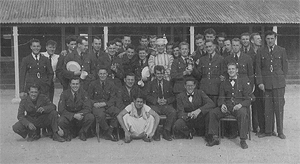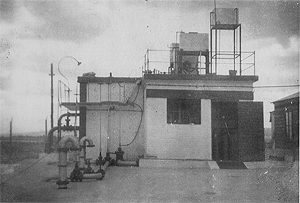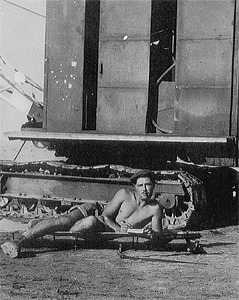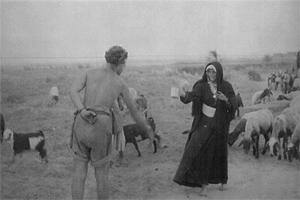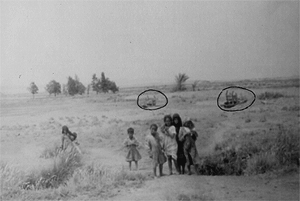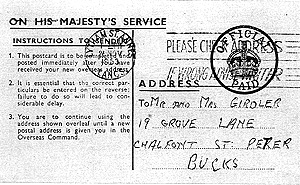To begin at the beginning, prior to National Service I worked in a local garage and felt the basic skills acquired might be of use to the RAF. No such luck I’m afraid. After Basic Training at RAF Hermesford and end of training leave, I found myself at RAF Church Lawford to be trained in the skills of Airfield Construction and Airfield Maintenance. The camp, at the time, was a holding camp for those within Airfield Maintenance/Construction who had completed a task and awaited further duties. At the time, Church Lawford had a large number of reservists kicking their heels and those who had just returned from the Lynmouth Floods. The training was very basic – plant and equipment, runway construction, concreting, hand diggingtools and the laying of pierced steel planking to construct temporary runways. Any posting from Church Lawford was likely to be overseas. Postings to Germany, for the time being, were complete. There were no postings to the Far East as the war in Korea had ended. So here we are, only a choice of one (no options) – Egypt, Canal Zone.
Two days holding at Lytham St. Annes in November which was a desolate time in any seaside town. Off to RAF Lyneham; onto Malta – change ofcabin crew and re-fuelling, with the final leg to land at RAF Faid in the early hours of the morning. It was dark with an azure blue night sky speckled with literally millions of stars. Down the Canal Road, plunging from nighttime darkness to searchlight brightness as we trundled through a series of checkpoints. Issued with blankets and collapseable beds, we staggered into tents pitched on fine desert sand. The next morning we found the cookhouse and ate of Egyptian soil for the first time. The menu was always reliable with no surprises. Porridge for breakfast with, sometimes, baked beans, triangular sausages and hardtack biscuits at midday and for tiffin, bread, jam and liquid marge. I suppose using the word ‘Tiffin’ at four o’clock we could imagine we were dining at the Ritz. There was always a long queue at the serving hatches and if the cooks were late in serving there was aloud chorus of “Why are we waiting”. The midday food serving always involved the Duty Officer’s ritual of “Are there any complaints?”. One wag spoke up and voiced the opinion that “there was no sugar in the tea” and for that one bold voice there was seven day of reporting to the Guardroom.
I found myself part of 5003 Squadron involved in Airfield Maintenance. There was also 5002 Squadron for Airfield Construction. There was within 5003 Sqdn General Duties Bods (myself included) and the skilled part of Airfield Maintenance – plumbers, carpenters, bricklayers, electricians and even the maintenance of camp bicycles. After 48 hours at Kabrit it rained for the first time in eighteen months. Puddles appeared on the roadways and there was gawping everywhere. Then the reality of Egypt struck: I spent three days in hospital with a Gypo gut I was discharged just before Christmas to resume my duties at the Waste Filtration Plant – eight hours on, sixteen off for the next thirteen months.
|
5002 & 5003 Sqdn dressed for Christmas Dinner 1953 |
Being on continual duty meant no involvement in conventional camp guard duties, but everyone at the Plant was armed with a Sten gun which was drawn from the Armoury with ammunition and returned eight hours later. The Water Filtration Plant was at the edge of the camp surrounded by barbed wire and positioned to draw a regular supply of water via a sump from the Sweetwater Canal. This system had been built by the Royal Engineers in the inter-war period. The Canal sump was cleaned once a year by the Egyptian crew we worked with. The cleaning was a point of jubilation; many large eels were caught, killed and cooked by the Egyptians. I suppose a very welcome change of diet. After being drawn from the Canal, the water was treated with copper sulphate crystals, the alum was added (as a settling agent), the water was then chlorinated and passed through a fine sand filter bed before being stored in underground tanks to be pumped up into the water tank tower before distribution throughout the camp. At the Plant there were standby pumps and generators which bore the appearance of being pre-war.
The Water Filtration Plant on RAF Kabrit
|
The longest shift was always from 22:00 hours to 06:00 hours. The camp was asleep, the NAAFI and YMCA were shut and the cinema doors bolted. The only break in patrol and readings was at 02:00 hours when a stroll to the cookhouse was made to collect a can of tea. The stroll was usually casual dress with hat removed. Terror struck one morning when the Station Warrant Officer saw this vision of a hatless airman wandering about. Who was most surprised, I don’t know; but we can all guess whose wrath was exercised on whom!
Having spent over a year on Water Filtration, I was moved on to Airfield Maintence duties, but before moving on, one picture of two airmen on shift at the Water Filtration Plant – I cannot remember the names, the only thing I recall was one came from Birmingham and the other from Norfolk. (Can anyone give names to the faces below?)
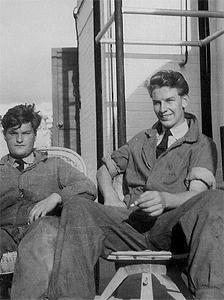
5003 SQUADRON – KABRIT
DREDGING THE SWEET WATER CANAL
I was transferred from the Water Filtration Plant to General Duties outside the shift system and a move to bunk accommodation – farewell tented abode! This change was very welcome but it took a long time to get used to the screech of fighter jets as they took off and landed on circuit and pump exercises during the day when sleep was needed.
My new lodgings was Bunk C3 with three beds and a verandah, all surrounded by sand – what more could be expected? The sand was “brushed” every morning – I thought that this was just a version of “Military Landscaping” but have since been told that this was to show footprints if the bunks were broken into. These bunks had once been senior NCO accommodation - near the shower block and latrines. A decent nights sleep at last. The fact that Kabrit had moved from flying Meteor jets to Lightings or Vampires (not sure) had little effect on those not involved in flying; the only noticeable effect was the pitch of a Meteor’s engine was lower than its replacement.
Sharing a bunk with me was LAC Lewis who, at the time, was the RAF Heavyweight Boxing Champion. What became of Lewis ‘the Cockney’, who idolized Ava Gardener, would be interesting to know. A return to the Eastend of London (his home) was so obvious – but what else? Tommy Graham was also in Bunk C3, a Scotsman who had been a semi-professional footballer before he took the Queens Shilling. Amongst 5002 Squadron was a player for the RAF water polo team – Brummy Wickes – again, where are you now?

Water Polo on the Little Bitter Lake, Kabrit
Life now became more varied working with the Airfield Maintenance tasks, repairing office furniture and laying aircraft pans at the edge of the runway. Whilst shoveling sand to make a depression for the pan a nest of scorpions was disturbed and it was proved that every scorpion mum looks after their offspring very well. Once the pans were completed, work commenced on dredging the Sweet Water Canal some miles outside the camp confines.
This was a welcome chance for a plant operation/excavator driver and two escorts to brew tea and keep guard with a trusty Sten gun. Hourly calls were made by short-wave radio to ensure all was OK. The call sign to Kabrit was “Gamecock to Peter X ray” – how that is imprinted on my brain still! So here we were, tent erected, digger in place and real Egyptians from the nearby village and regular visits from female Bedouin goat herders.
This dredging was guarded at night by the RAF Regiment. A mobile generator provided illumination after sunset. It was at the point of change-over one evening that the generator was stolen on the back of a donkey! In all probability, those present from the RAF Regiment got it in the neck in a big way as the Regiment always seemed to be at the sharp end; blackened faces and ghost patrols across the airfield looking for intruders at night and special ceremonial duties. They were a specially selected unit of the Regiment trained to Parade before The Queen in Tripoli during 1954. Who can recall that? Many years after National Service my ultimate boss was George Stockday who was a newly commissioned officer in the RAF Regiment at Kabrit. Does the name ring any bells? George eventually rose to the rank of Group Captain. A good, level headed sort of bloke in my opinion.

